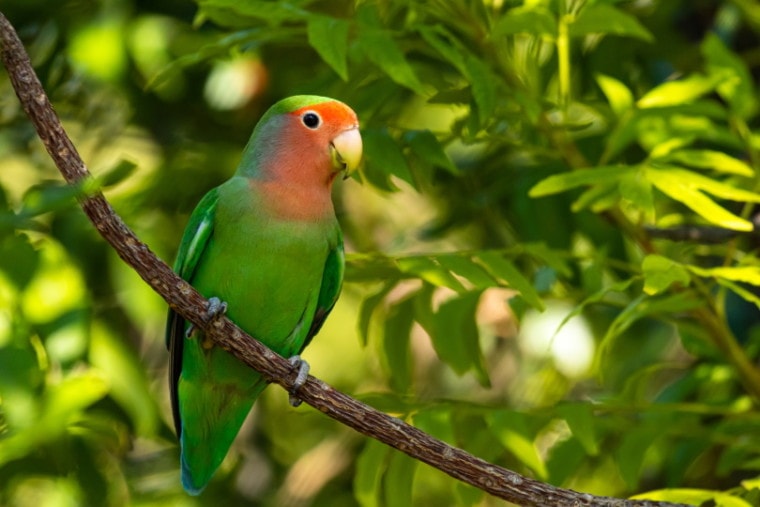
Lovebirds are among the most social and loving birds on the planet, but that doesn’t mean they’re the easiest birds to care for. They require a bit of work and patience and a ton of consistency, but the payoff is huge.
They’re extremely loving creatures that can bond with a human in a way that few other birds can. But what do you need to do to care for these tiny birds, and what should you expect if you get one? We answer both those questions and more here.
Species Overview

| Common Names: | Lovebirds |
| Scientific Name: | Agapornis |
| Adult Size: | 5 to 6.5 inches |
| Life Expectancy: | 10 to 20 years |
Origin and History
Lovebirds are originally from the forests and savannas of Africa and Madagascar. However, today, you can find wild Lovebirds all over the globe, including in the United States, and the closest living relatives to pet Lovebirds reside in Asia!
People have been keeping birds as pets since as early as 5000 BC, and there’s no reason to believe that Lovebirds weren’t among the first domesticated birds.
In any case, there are plenty of domesticated Lovebirds to choose from, and many of them have different color variations and patterns that you would never find in the wild!
Temperament
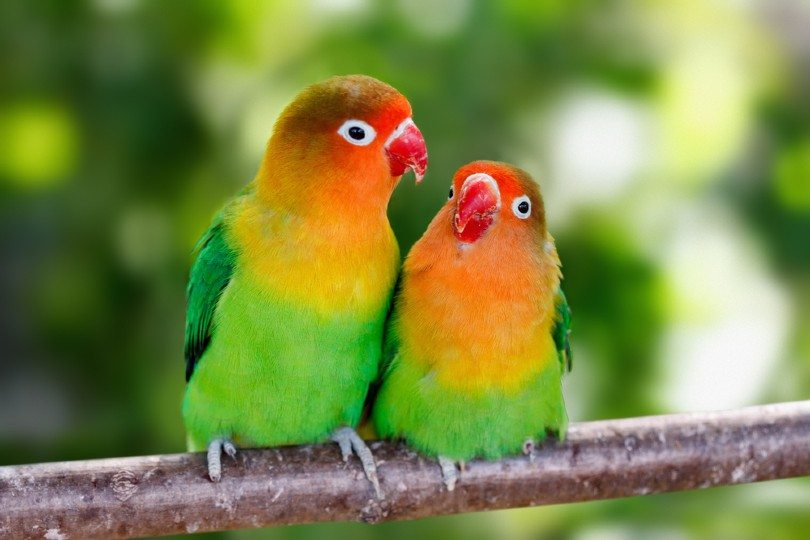
While Lovebirds have a sweet and energetic temperament, you must tame them from birth to reach this stage. Lovebirds that don’t get daily attention can start to nip, and eventually, they won’t even let you handle them!
This makes them a little more stubborn and tricky than other small birds, like Parakeets, but they are also far more intelligent, making them well worth the extra trouble.
Keep in mind that females tend to be a bit more temperamental than males after reaching sexual maturity. Also, expect that your Lovebird will likely only bond with one human, and they might be temperamental to anyone else out of jealousy.
Still, if you care for your Lovebird properly and handle them daily, they will crave attention as much as you do, which is excellent for those looking for a hands-on pet that they can play with daily!
Not only are Lovebirds sweet and energetic, but they also have a playful and curious nature. They’re great as either an only bird or with a companion, which brings about even more fun possibilities!
Speech & Vocalizations
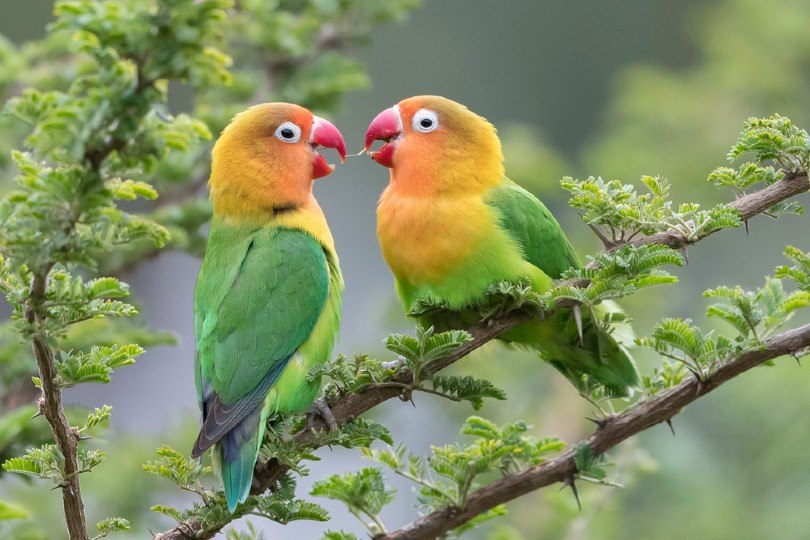
There’s little doubt that a Lovebird is a noisy bird. They love to chatter and make noise, so they’re not ideal for apartment living. Additionally, they are parrots, which means you can teach them to chirp and make noises when you tell them to.
In fact, with enough training and practice, your Lovebird can even learn a few words! Of course, they’re only mimicking you, so don’t expect them to actually know what you’re saying or talking about.
Lovebird Colors and Markings
Lovebirds come in a wide array of colors. They can range from peach to green and just about everything in between. However, most pet Lovebirds have a green plumage, and their face and heads tend to be different colors than their bodies.
Since many breeders have mixed different Lovebirds, there is a wide range of color options out there, many of which you’d never find in the wild.
Most female and male Lovebirds look identical, meaning it’s extremely difficult for an inexperienced hand to determine their sex.
Lovebirds have short and stocky bodies with short tail feathers, which gives them a unique appearance compared to many other birds.
Caring for the Lovebird

Caring for a Lovebird isn’t the easiest task in the world compared to many other birds, but it’s still far easier than many other pets. You need to handle your Lovebird daily to prevent them from nipping, and they typically only bond to one person.
Once they bond to that person, they tend to get jealous of anyone else they think is stealing away attention, and they might nip them as a result. You can choose to get two Lovebirds in the same enclosure, but any more might result in fights. Again, this is because of jealousy. Lovebirds mate for life, so once they find a mate, they’ll get jealous of anyone else taking their partner’s attention away. But having a pair of Lovebirds is an extremely rewarding experience because they’ll stay around each other constantly while they preen.
Lovebirds eat a mix of fresh vegetables and fruit and don’t have any special dietary concerns.
You also should bathe your Lovebird every once in a while, but this doesn’t require any special soaps or anything. Simply provide enough water to cover your Lovebird, and let them handle the rest!
In the end, the most important part of caring for a Lovebird is spending enough time with them. Once they bond, Lovebirds crave tons of attention, so ensure that you can devote it to them before bringing them into the family.
Common Health Problems
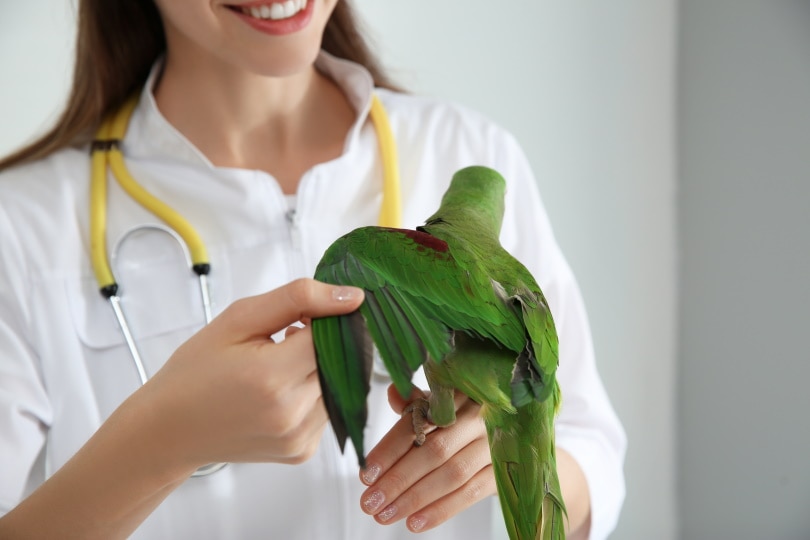
While Lovebirds are relatively healthy birds, there are a few concerns that you need to watch out for. It’s especially important to keep an eye out for potential problems because Lovebirds will conceal their illnesses for as long as possible.
So, if you’re noticing symptoms, you’ll need to take your Lovebird to a vet right away. Common illnesses include:
The best thing that you can do to keep your Lovebird healthy is to give them a high-quality diet and keep their cage conditions clean and well cared for. However, keep in mind that these birds are prone to social and anxiety problems like depression. This is a common problem when your Lovebird isn’t getting enough attention from you, and they can resort to self-mutilating behaviors and lose weight if they stop eating.
Diet and Nutrition

One of the most important things that you can do to keep your Lovebird healthy is to give them a well-balanced diet that has all the nutrients that they need. Avoid seed-only diets, and introduce a ton of variety to ensure that your bird can’t become a picky eater.
Feed your Lovebird tons of fresh veggies and the occasional fruits, and mix in nuts, berries, and other Lovebird-specific foods, so they get everything that they need to stay happy and healthy.
You should feed your Lovebird daily, and if you can feed them twice a day, that’s even better. You need to feed your Lovebird between 1.5 to 2 ounces of food every day to keep them healthy.
Since Lovebirds are so small, they can’t skip meals or go without eating for an extended period. If they do, they will start exhibiting serious health concerns that you’ll need to address right away.
Exercise
Lovebirds are high-energy birds and need as much space as possible to stay happy. The larger the cage, the better for a Lovebird, and they should have plenty of perches that they can fly to and use.
But don’t assume that your Lovebird will be happy just because you give them a large cage. Lovebirds still need plenty of time to roam outside of their enclosure, and the more time that they can fly around and exercise, the better.
If your Lovebird doesn’t get enough exercise, you might start to notice self-mutilating behaviors, like feather pulling.
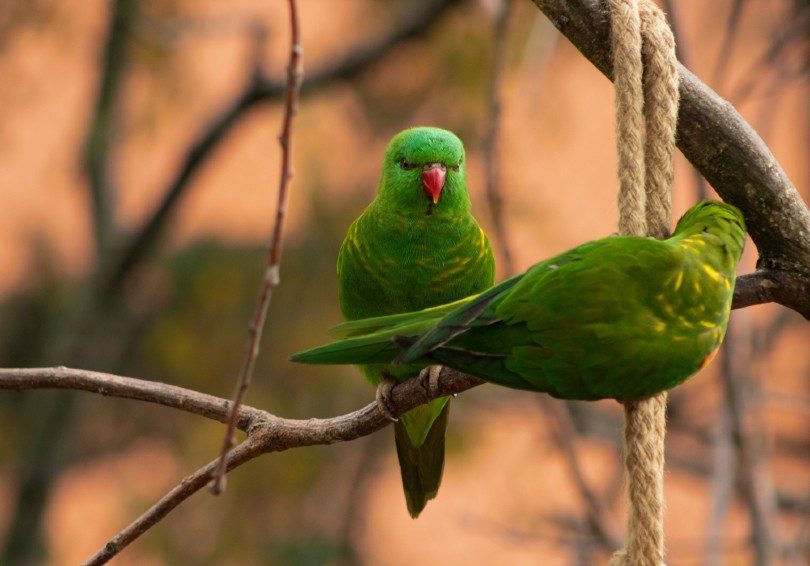
Where to Adopt or Buy a Lovebird
Lovebirds are relatively common pets, and as such, you can find them at most pet stores. They’re also not overly expensive! Most Lovebirds cost between $40 and $130, depending on the color variations that you choose.
If you’re not picky about your Lovebird, you can find them at most pet stores, but if you’re looking for a rare breed or color pattern, you might have to track down a specific breeder, and you should expect to spend a little more.
You also might need to hit up multiple stores to buy a second Lovebird, and you need to ensure that you’re not getting a male and a female unless you plan on breeding them.
Final Thoughts
With so much to love about these adorable creatures, it’s no wonder that Lovebirds are always booming in popularity. But you need to keep in mind that they can have a long lifespan and are labor-intensive to care for.
While neither of these things is a dealbreaker, the last thing that you want is to leave your Lovebird heartbroken because you no longer have the time to hang out with and take care of them!
What to read next:
Featured Image Credit: Jearu, Shutterstock








